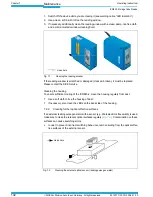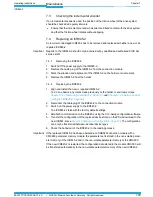
Operating Instructions
Chapter 8
ICR845-2
Troubleshooting
8012377/0000/2008-01-30
©
SICK AG · Division Auto Ident · Germany · All rights reserved
113
8.5.3
Malfunctions in Reading mode: Result output errors
Prerequisite
The "Device Ready" LED lights up. If not, see
Table 8-3, Page 109
.
The reading pulse is functioning correctly. If not, see
Table 8-4, Page 110
.
General malfunctions
Fault
Possible cause
Remedy
No Read:
1. The "Result" LED (default setting: "Good
Read") does not light up at the end of the
reading pulse.
– The "Result 2" switching output (de-
fault setting: "Good Read") does
not output a pulse
– The ICR845-2 outputs the status
ST = 2 in the reading result of the
host interface (if ST is enabled for out-
put in the Reading data on the D
ATA
S
TRINGS
tab; this is not selected in the
default setting)
– The ICR845-2 outputs the system
message "no code" via the auxiliary in-
terface (Terminal Emulator of CLV-
Setup)
Read not successful, since there was no
code in the illumination field during the
reading pulse
Code not completely within the distance-
dependent field of view (red illumination
field positioned incorrectly)
Code presented at incorrect reading
distance
Evaluation range of the field of view in
the matrix sensor was incorrectly limited
(image geometry or area of interest)
Insufficient light on the reading area
First perform the reading while the code
is stationary, then while the code is
moved. Check the content of the image
memory with CLV-Setup/ImageFTP: trig-
ger the ICR845-2; is the code in the im-
age memory once the reading cycle is
complete?
Align ICR845-2:
ICR845-2C: field of view 44 mm x
28 mm (1.73 in x 1.1 in) at reading dis-
tance 115 mm (4.53 in)
(see also
Chapter 9.3 Specification dia-
gram, Page 124
).
Is the code in the center of the illumina-
tion field? For remedy, see above.
If necessary, call up P
ERCENTAGE
E
VALUA
-
TION
(see
Chapter 6.9.2 Percentage Eval-
uation, Page 81
).
Check: reading distance of code in spec-
ified reading range?
See also
Chapter 9.3 Specification dia-
gram, Page 124
.
Check with image output via ImageFTP:
Is the code recorded in sharp focus in the
image memory?
Check with image output via ImageFTP:
Has all the code been recorded in the im-
age memory?
Check with CLV-Setup:
Select the R
EADING
C
ONFIGURATION
tab,
click the C
ODE PROPERTIES
P
ARAMETERS
but-
ton, find the I
MAGE
G
EOMETRY
section:
Active evaluation range ok?
Select the R
EADING
C
ONFIGURATION
tab.
Find the A
REA OF INTEREST
section:
Are the min. and max. code position val-
ues correct?
Check with CLV-Setup:
Select the R
EADING
C
ONFIGURATION
tab,
click the C
ODE PROPERTIES
P
ARAMETERS
but-
ton, find the I
NTERNAL
I
LLUMINATION MODE
section: is the number of selected seg-
ments sufficient? See also
Chapter b) Il-
lumination mode, Page 128
Tab. 8-5: Troubleshooting: Result output errors in Reading mode (general malfunctions)
















































